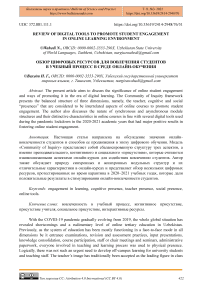Review of digital tools to promote student engagement in online learning environment
Автор: Wahedi Nargiza
Журнал: Бюллетень науки и практики @bulletennauki
Рубрика: Педагогические науки
Статья в выпуске: 3 т.8, 2022 года.
Бесплатный доступ
The present article aims to discuss the significance of online student engagement and ways of promoting it in the era of digital learning. The Community of Inquiry framework presents the balanced structure of three dimensions, namely, the teacher, cognitive and social “presences” that are considered to be interrelated aspects of online courses to promote student engagement. The author also discusses the nature of synchronous and asynchronous module structures and their distinctive characteristics in online courses in line with several digital tools used during the pandemic lockdown in the 2020-2021 academic years that had major positive results in fostering online student engagement.
Engagement in learning, cognitive presence, teacher presence, social presence, online tools
Короткий адрес: https://sciup.org/14123636
IDR: 14123636 | УДК: 372.881.111.1
Список литературы Review of digital tools to promote student engagement in online learning environment
- Buelow, J. R., Barry, T., & Rich, L. E. (2018). Supporting learning engagement with online students. Online Learning, 22(4), 313-340.
- Knowles, M. S. (1975). Self-directed learning: A guide for learners and teachers.
- Kuh, G. D. (2003). What we're learning about student engagement from NSSE: Benchmarks for effective educational practices. Change: The magazine of higher learning, 35(2), 24-32. https://doi.org/10.1080/00091380309604090
- Dixson, M. D. (2015). Measuring student engagement in the online course: The Online Student Engagement scale (OSE). Online Learning, 19(4), n4.
- Nguyen, T. D., Cannata, M., & Miller, J. (2018). Understanding student behavioral engagement: Importance of student interaction with peers and teachers. The Journal of Educational Research, 111(2), 163-174. https://doi.org/10.1080/00220671.2016.1220359
- Garratt-Reed, D., Roberts, L. D., & Heritage, B. (2016). Grades, student satisfaction and retention in online and face-to-face introductory psychology units: A test of equivalency theory. Frontiers in psychology, 7, 673. https://doi.org/10.3389/fpsyg.2016.00673
- Paulsen, J., & McCormick, A. C. (2020). Reassessing disparities in online learner student engagement in higher education. Educational Researcher, 49(1), 20-29. https://doi.org/10.3102/0013189X19898690
- Castellanos-Reyes, D. (2020). 20 years of the community of inquiry framework. TechTrends, 64(4), 557-560. https://doi.org/10.1007/s11528-020-00491-7
- Fiock, H. (2020). Designing a community of inquiry in online courses. The International Review of Research in Open and Distributed Learning, 21(1), 135-153. https://doi.org/10.19173/irrodl.v20i5.3985
- Garrison, D. R., & Arbaugh, J. B. (2007). Researching the community of inquiry framework: Review, issues, and future directions. The Internet and higher education, 10(3), 157172. https://doi.org/10.10167j.iheduc.2007.04.001
- Shea, P., Li, C. S., & Pickett, A. (2006). A study of teaching presence and student sense of learning community in fully online and web-enhanced college courses. The Internet and higher education, 9(3), 175-190. https://doi.org/10.10167j.iheduc.2006.06.005
- Peterson, A. T., Beymer, P. N., & Putnam, R. T. (2018). Synchronous and asynchronous discussions: Effects on cooperation, belonging, and affect. Online Learning, 22(4), 7-25.
- Swan, K. (2001). Virtual interaction: Design factors affecting student satisfaction and perceived learning in asynchronous online courses. Distance education, 22(2), 306-331. https://doi.org/10.1080/0158791010220208
- Emelyanova, N., & Voronina, E. (2014). Introducing a learning management system at a Russian university: Students' and teachers' perceptions. International Review of Research in Open and Distributed Learning, 15(1), 272-289. https://doi.org/10.19173/irrodl.v15i1.1701
- McDaniels, M., Pfund, C., & Barnicle, K. (2016). Creating dynamic learning communities in synchronous online courses: One approach from the Center for the Integration of Research, Teaching and Learning (CIRTL). Online Learning, 20(1), 110-129.


